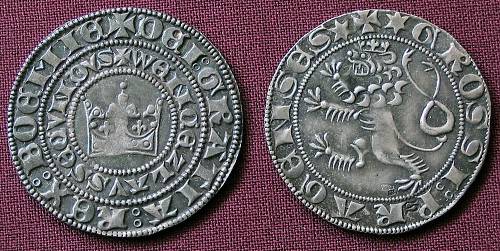Ten lev by mohl hrát okamžitě v nějaké nové české animované pohádce.
1.7. 1300 Minting of the Prague grosz began
Categories: Minting - Numismatics , Calendar

Thanks to the silver from Kutná Hora, Charles IV was able to build Charles Bridge, Prague's New Town, Karlstejn and many other buildings. From 1300, Václav II had silver minted in Kutná Hora. Prague grosz.
At the end of the 13th century, rich deposits of silver were discovered in Kutná Hora. At that time, one third of the silver in Europe was produced there. In 1300, King Wenceslas II of Bohemia, the richest of all the Přemyslids, had the famous silver Prague groschen minted here. Minting took place over two hundred years.
The Prague grosz was modelled on the Florentine grosz (grosso). "In the year of our Lord 1300, in the month of June, six experienced men came from Florence at the invitation of Mr. Wenceslas, and at the king'sKutná Hora, they minted new coins, namely the Prague grosz and small money," Jan Kvirenc and Eliška Kunstova write in their book Czech History to 1914.
Thanks to the silver from Kutná Hora, the Czech kingdom was very rich, especially in the 14th century, and the Prague grosz were welcomed throughout Europe. Charles IV had Charles Bridge, Prague's New Town, Karlstejn and many other buildings built thanks to Kutná Hora silver.
"Without exaggeration, we can call the Prague grosz the dollar or the euro of the High Middle Ages. It had such financial power that it became a sought-after currency all over the world at that time. For one groschen you could buy a chicken, for a few hundred groschen a horse. It's not really possible to convert the grosz into today's crowns, because chickens and horses were bothtimes played a completely different role than today, but it gives at least an approximate idea," writes Jan A. Novák in his book Charles VI - Mystic and Sorcerer.
The central royal mint for the entire Czech Kingdom was also established in Kutná Hora at that time. As far as gold, silver and the desired currency were concerned, Charles came to the ready and could only harvest. Rich deposits of silver ore were intensively mined in Kutná Hora in the 14th and 15th centuries. It was the rich yields of the Kutná Hora mines, together with the valuable currency, that contributed significantly to the wealth and power of the Bohemian Kingdom.
In the 16th century, mining of rich silver-bearing ore veins began to develop in the vicinity of Jáchymov in the Ore Mountains. A mint was also established here, where valuable thalers were minted. Nowadays, the main source of silver in the world are ore veins containing various sulphides with a greater or lesser admixture of silver. These include mainly pyrite, sphalerite and galena. In the 19th century, our main source of silver was silver-bearing galena mined in Pribram.
Sources. Novák, Charles VI - Mystic and Sorcerer
The article is included in categories:











 tuhle minci najit a jeste aby byla v nejakem slusnem stavu je muj sen =)
tuhle minci najit a jeste aby byla v nejakem slusnem stavu je muj sen =)